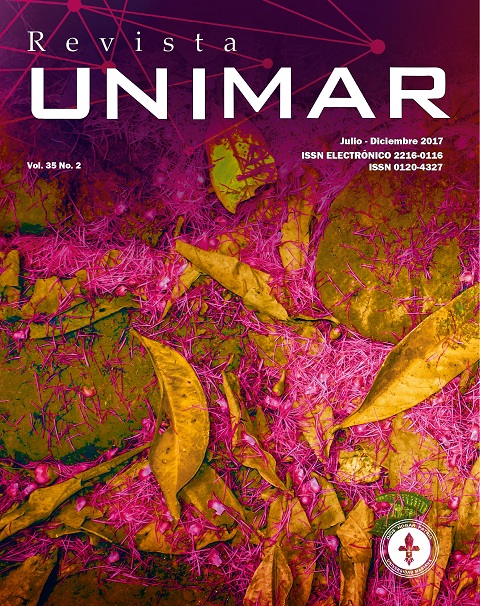Reconstruction of 3d objects with axial symmetry from laser triangulation
Keywords:
3D Reconstruction, laser triangulation, optical metrology, axial simmetryAbstract
This article describes the 3D reconstruction of an object that possesses axial symmetry from the laser triangulation method; the system allows obtaining the shape and dimensions of an object by directional light projection in structured form and controlled rotation of the object. The system consists of a lighting stage through the projection of a laser line, a system of acquisition through the use of a webcam and the design of a platform that is responsible for the rotation controlled by a motor coupled to a box speed reducer. The software application allows synchronizing the system through the USB port, to finally perform the image processing and the display of the results obtained in a graphical interface. Experimental design considerations and their limitations as minimum resolution, accuracy of measures are detailed in this article.
Author Biographies
Dagoberto Mayorca Torres, Universidad Mariana
Especialista en gerencia de proyectos Ingeniero Físico (Universidad del Cauca). Docente Facultad de Ingeniería (Universidad Mariana), integrante del Grupo de Investigación GRIM de la Universidad Mariana
Anghelo Marino López, Universidad Mariana
Candidato a Magister en Sistemas Automáticos de Producción (Universidad Tecnologica de Pereira). Ingeniero Electronico (Universidad de Nariño). Director de Ingeniería mecatrónica, Integrante del Grupo de Investigación GRIM de la Universidad Mariana
References
Ahmed, M. & Farag, A. (2005). Non metric calibration of camera lens distortion: differential methods and robust estimation. IEEE Transactions on Image Processing, 14(8), 1215-1230. https://doi.org/10.1109/TIP.2005.846025
Argüello-Sarmiento, G., Barrero-Pérez, J. y Meneses-Fonseca, J. (2012). Reconstrucción tridimensional de objetos con simetría axial a partir del método de triangulación láser con múltiples sistemas de observación. Revista UIS Ingenierías 11(2).
Castañeda, R. (1994). Interferometría de Speckles. Revista de la Facultad de Ciencias, 4(2),Universidad Nacional de Colombia, Sede Medellín.
Cock, J. (2000). El método de la triangulación aplicado en un escaner laser, para objetos tridimensionales. Revista Universidad Eafit,25-31.
Forest, J. (2004). New methods for triangulation-based shape acquisition using laser scanners (Tesis doctoral). Universitat de Girona.
Geng, J. (2011). Structured-light 3D surface imaging: a tutorial. Advances in Optics and Photonics, 3(2), 128-160. https://doi.org/10.1364/AOP.3.000128
Kus, A. (2009). Implementation of 3D Optical Scanning Technology for Automotive applications. Recuper-ado de https://www.ncbi.nlm.nih.gov/pmc/articles/PMC3345859/ https://doi.org/10.3390/s90301967
Moccozet, L., Dellas, F., Magnenat-Thalmann, N., Biasotti, S., Mortara, M., Falcidieno, B. ... Veltkamp, R. (s.f.). Animatable Human Body Model Reconstruction from 3D Scan Data using Templates. Recuperado de http://www.patrickmin.nl/pubs/moccozet04.pdf
Lam, L., Lee, S. & Suen, C. (1992). Thinning Methodologies - A Comprensive Survey. IEEE Transactions on Pattern Analysis and Machine Inteligence, 14(9), 869-885. https://doi.org/10.1109/34.161346
Ledezma, Ó., Patiño, A. & Patiño, J. (2007). 3D Surface Scanner for Fuzzy Objects. Revista Colombiana de Tecnologías de Avanzada 2(10), 131-134.Real Academia Española. (RAE). (2011).
Real Diccionario de la Academia de la Lengua Española, RAE, vigésima segunda edición virtual. Recuperado de http://www.rae.es/rae.html
Santolaria, J., Aguilar, J., Lope, M., Yagüe, J., Royo, J. y Puertas, J. (s.f.). Digitalización rápida de modelos: métodos, instrumentos, estrategias de digitalización y análisis de la precisión obtenida mediante un sensor láser por triangulación. Recuperado de http://www.egrafica.unizar.es/ingegraf/pdf/comunicacion17058.pdf
Schnee, J. & Futterlieb, J. (2011). Laser Line Extraction with Dynamic Line Models. Recuperado de https://link.springer.com/chapter/10.1007/978-3-642-23672-3_16 https://doi.org/10.1007/978-3-642-23672-3_16
Tsai, R. (1987). A versatile camera calibration technique for high-accuracy 3D machine vision metrology using off-the-self TV cameras and lenses. IEEE Journal of Robotics and Automation, 3(4), 323-344. https://doi.org/10.1109/JRA.1987.1087109
Weng, J., Huang, T. & Ahuja, N. (1989). Motion and structure from two perspective views: algorithms, error analysis and error estimation. IEEETransactions on Pattern Analysis and Machine Intelligence 11(5). https://doi.org/10.1109/34.24779
Zhang, T. y Suen, C. (1984). A Fast Parallel Algorithm for Thinning Digital Patterns. Communications of the ACM 27(3), 236-239. https://doi.org/10.1145/357994.358023
Zhang, Z. (1998). A flexible new technique for camera calibration. Recuperado de citeseerx.ist.psu.edu/viewdoc/download?doi=10.1.1.220
How to Cite
Downloads
Downloads
Published
Issue
Section
License

This work is licensed under a Creative Commons Attribution 4.0 International License.
Los autores que publiquen en esta revista aceptan las siguientes condiciones:
1. Los autores conservan los derechos de autor y ceden a la revista el derecho de la primera publicación, con el trabajo registrado con la licencia de atribución de Creative Commons, que permite a terceros utilizar lo publicado siempre que mencionen la autoría del trabajo y a la primera publicación en esta revista.
2. Los autores pueden realizar otros acuerdos contractuales independientes y adicionales para la distribución no exclusiva de la versión del artículo publicado en esta revista (p. ej., incluirlo en un repositorio institucional o publicarlo en un libro) siempre que indiquen claramente que el trabajo se publicó por primera vez en esta revista.
3. Se permite y recomienda a los autores publicar su trabajo en Internet (por ejemplo en páginas institucionales o personales) antes y durante el proceso de revisión y publicación, ya que puede conducir a intercambios productivos y a una mayor y más rápida difusión del trabajo publicado (veaThe Effect of Open Access).
Altmetric
| Article metrics | |
|---|---|
| Abstract views | |
| Galley vies | |
| PDF Views | |
| HTML views | |
| Other views | |








